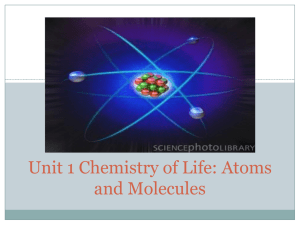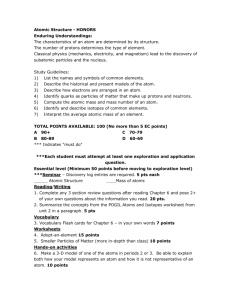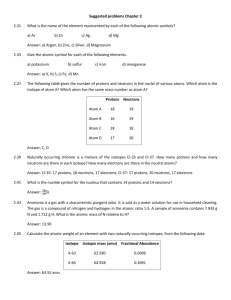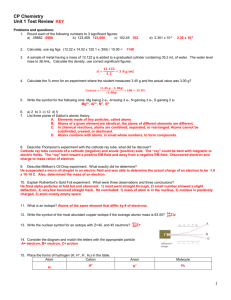CHAPTER 4 – ATOMIC STRUCTURE:
advertisement
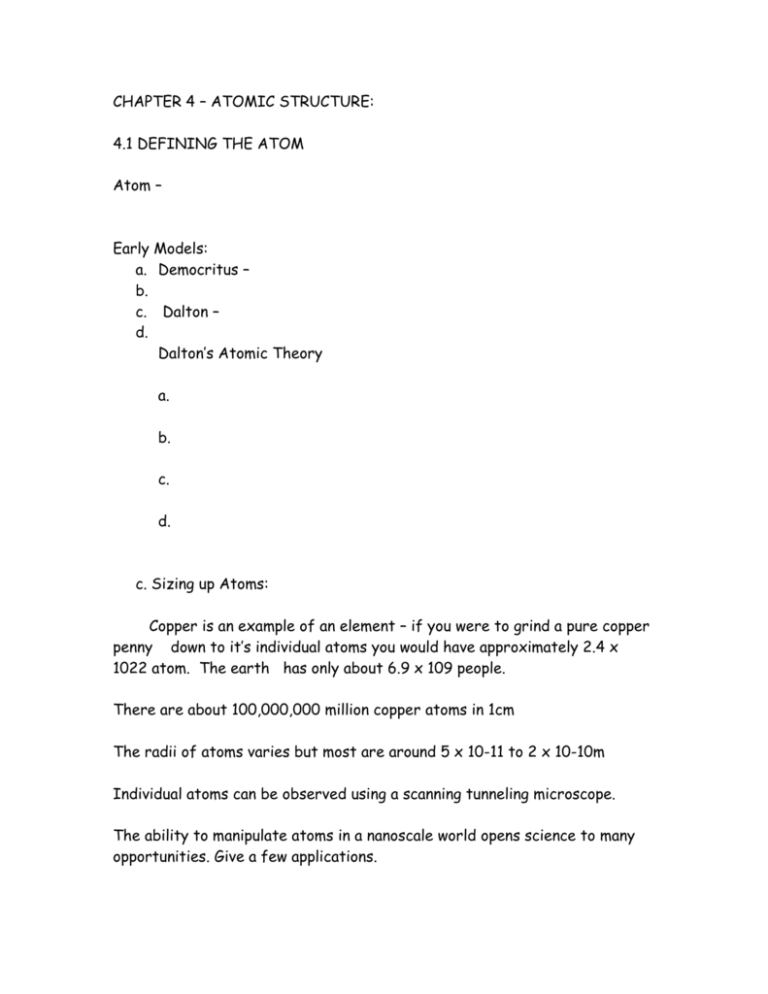
CHAPTER 4 – ATOMIC STRUCTURE: 4.1 DEFINING THE ATOM Atom – Early Models: a. Democritus – b. c. Dalton – d. Dalton’s Atomic Theory a. b. c. d. c. Sizing up Atoms: Copper is an example of an element – if you were to grind a pure copper penny down to it’s individual atoms you would have approximately 2.4 x 1022 atom. The earth has only about 6.9 x 109 people. There are about 100,000,000 million copper atoms in 1cm The radii of atoms varies but most are around 5 x 10-11 to 2 x 10-10m Individual atoms can be observed using a scanning tunneling microscope. The ability to manipulate atoms in a nanoscale world opens science to many opportunities. Give a few applications. STRUCTURE OF THE NUCLEAR ATOM Subatomic particles: • • Atoms are divisible! The three subatomic particles are protons, neutrons, and electrons Atomic Part Location Charge Mass Symbol Change Proton Neutron Electron J.J. Thomson (1856-1940) – discovered the electron by passing electric current through gases at low pressure. The cathode ray, a glowing beam, travels from the negatively charged cathode to the positively charged anode. He then deflected the beam using a magnet. How did he know the charge of the beam? What did Thompson discover about the ratio of the charge of an electron to its mass? Robert A Millikan – (1868-1953) used the charge to mass ratio of an electron to calculate the mass of an electron. His value for charge and mass are similar to today’s accepted value. Consider these four presuppositions; 1. 2. 3. 4. Eugene Goldstein – (1850-1930) observed rays in a cathode ray tube traveling in a direction opposite to that of the cathode ray. He called them canal rays James Chadwick – (1891 – 1974) – confirmed the existence of the neutron Ernest Rutherford – (1871-1937) a former student of Thompson gave shape to today’s image of an atom. In 1911 his gold foil experiment yielded evidence of an atomic nucleus with a large area of space around surrounding that nucleus. How did he come to this conclusion? 4.3 DISTINGUISHING AMONG ATOMS Atomic Number – Mass Number – Give the number of protons, neutrons, and electrons for the following atoms ISOTOPE: Atoms that have the same number of protons but different number of neutrons ATOMIC MASS: Although the actual masses of individual atoms are useful, it is more useful to compare the relative masses of atoms using a reference isotope as a standard. The isotope that was chosen is Carbon – 12 and was assigned a mass of exactly 12 atomic mass units. Atomic Mass Unit: (amu) Is defined as one twelfth of the mass of a carbon – 12 atom. Magnesium has three isotopes. 78.99% magnesium 24 with a mass of 23.9850 amu, 10.00% magnesium 25 with a mass of 24.9858 amu, and the rest magnesium 26 with a mass of 25.9826 amu. What is the weighted average atomic mass of magnesium? To calculate the atomic mass of an element, multiply the mass of each isotope by its natural abundance, expressed as a decimal, and then add the products. Weighted average mass = .7899 x 23.9850amu + .1000 x 24.9858amu + .1101 x 25.9826amu = 18.95amu + 2.499amu + 2.861amu = 24.31amu The atomic mass of an element is a weighted average mass of the atoms in a naturally occurring sample of the element and reflects both the mass and relative abundance of isotopes of that atom as they occur in nature. PERIODIC TABLE: Is an arrangement of elements organized in groups or rows with respect to similar traits shared by different elements. Groups – Periods –




